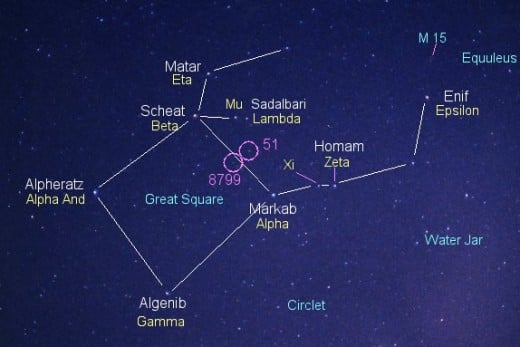Beyond Our Solar System-Exoplanet Giant,Gliese 581 And More
An Illustrative Comparison Of The Sun and Gliese Solar Systems
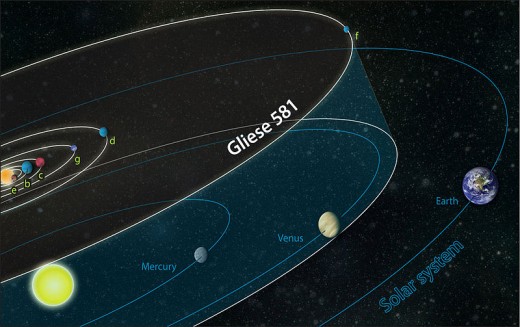
An Artist's Rendition of Gliese 581g As Viewed From Its Sun
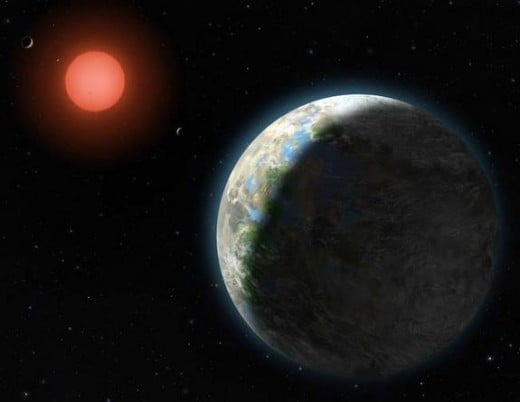
Artists Rendition Of The Kepler 11 Planetary System
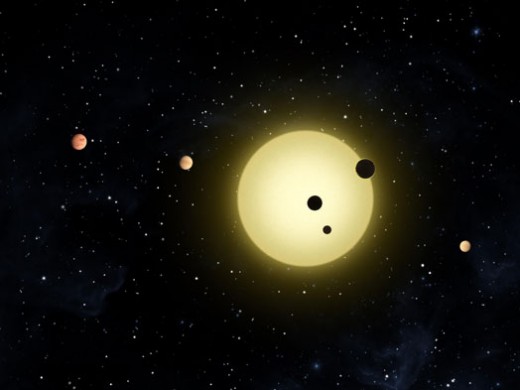
Two Suns Similar in Classification
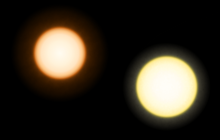
It sparks the imagination at the mere spectacle of envisioning an earthlike planet like our own or other giant Jupiter type planets, circulating light years away in their own separate and still blackness of space. Stars similar to our own sun, some smaller, and yet those that are much larger casting warmth on a world at a comfortable distance away that may be much like our own and for all we know harbors some sort of life form as we know it to be.
Sound too good be true, and possibly something that you hear about in a science-fiction story? Hardly!, in fact over the last decade scientists using large optical telescopes placed in orbit above the earth's atmosphere have detected such stars or suns and individual planets or worlds revolving around these other suns in a solar system much like that of earths own milky way. Mind boggling to say the least but something that should not seem too surprising to us. Given the fact that the Universe is a vast expanse which only we now have been able to tap with some of the best technology employed by implementing the Hubble Space Telescope and Kepler to name only a few.
Other solar systems with suns like our own, do in fact exist and have separate (exoplanets). A number of these outer planets, have been viewed directly by using a technique called direct imaging. While others have been detected utilizing space telescopes such as the Hubble, Kepler or Spitzer space telescopes. It's interesting to note that when we look at stars in the night sky, they mainly appear as direct points of light.
This is true for some of those stars. However it is only the great expanse or distance between many of those stars that make them appear as just that...tiny points of direct light. The fact of the matter is that about one of two stars we see are really two to three separate star systems. Which are at a relatively close proximity to one another.
Multiple star systems are two to three star systems that are orbiting around their center of mass. So in actuality they are much closer than they appear to be with the naked eye. Only powerful telescopes can discern this distance. So with this said and the countless possibility of multiple star systems being bountiful in the Universe. It is also relevant to think that there are numerous exoplanets orbiting around these star systems as well.
And one is correct in assuming so, even though to date, there have been only a handful of exoplanets discovered orbiting distant suns. They amount in number to a little more of what we could count on our own hands. And only two or three of these does suggest nearly a 100% possibility of harboring life on it, similar to that on earth.
And on the other end of the spectrum there are suns within solar systems that are very close to our own sun and solar system, with jupiter sized planets orbiting about them. However with a good many of these planets we still do not have all of the facts on whether they are indeed capable of supporting some sort of life form. There are far too many constellations that are composed of star systems and possible exoplanets to get into, within this particular article.
In the constellation Aquarius for example, there are five stars that comprise or make-up the 91 Aquari system. It was first discovered in late November of 2003 that a gas giant planet, (91 Aquari B), was orbiting the main star-91 Aquari A.
Within the constellation Pegasus, the great square, which can be observed sitting in the North Northeast winter sky of the northern hemisphere, lies three Jupiter size planets. They orbit a young spectral class A5 white dwarf star. Spectral classification of stars is defined as that given to stars, (eg.) W,O,B,A,F,G,K&M.
Spectral class W stars have the highest surface temperatures and are usually the most luminous. Stars of an M Class tend to be relatively cooler and are less luminous or bright. The sun is classified as a G2 yellow star. It has moderate warmth and surface brightness.
When scientists such as Astronomers search deep space for stars, that may harbor potential exoplanets capable of supporting some type of life. They mainly look at suns or stars that are similar to that of our own sun. Stars with a spectral classes of F or G for example, would be the best candidates for searching out potential life around these bodies.
Another factor that is considered is if the star within another solar system has what is called a Kuiper Belt or dust disk. The Kuiper Belt is an area of our solar system for example that is very similar to the asteroid belt, which lies between the orbits of Mars and Jupiter. It starts out at about the orbit of the planet Neptune and then extends outward to about 55 (A.U.). An A.U. or (Astronomical Unit), is equivalent to approximately 93,000,000 miles, or the distance that the earth is from the sun.
An asteroid belt that is located on the outer fringes of our solar system, called Kuiper. Is at least twenty times as wide and up to 200 times more massive than our own asteroid belt. The planet pluto, considered to be a dwarf planet is located in this belt. It is also an area where smaller objects formed. Smaller objects or remnants of the beginning of our solar system. Frozen objects for example ice, methane, ammonia and water are found here. These objects named here are also the building blocks that comets and asteroids are made of. And depending on the particular planetary or in question.
Astronomer's search for evidence of this particular zone or belt because depending on the distance from the star itself, could pose a problem for younger exoplanets trying to form in the region there around the parent star. The constant bombardment from comets and/or asteroids within this system could hamper the chances for life getting started there in the first place. So this is why, when examining other star systems, astronomers take these factors into consideration as well.
The star, Tau Ceti located about twelve light years distant from our own solar system, in the constellation Cetus the whale. It is a star that is very similar to our sun. And is classified as a spectrum G8 star. Our sun is classified as G2. It is also a yellow-orange dwarf star with a smaller mass than our own sun, which makes it a very good candidate for supporting life around it.
So far there have not been any exoplanets found orbiting the star Tau Ceti. It does contain a dust cloud, that is larger than that of our our own solar system, which as mentioned previously when speaking about the Kuiper belt and related dusk disks; further suggesting that it would be difficult for life to develop within these zones.
The same thought is suggested here, that the chance of life developing on an exoplanet around tau ceti as we know it to be; would be highly unlikely. Once again the reason being the greater possibility for comets and asteroids to bombard a newer planet in the making, and thus hindering its chances for the development of life on its surface.
On a further positive note is the star epsilon eridani, located within the constellation eridanus the river. Epsilon is the closest star system to that of our own sun. It is approximately ten light years distant and is classified as a spectral class K star. It is somewhat cooler than the sun and also younger, but shows much promise of supporting life within its realm.
Besides Tau Ceti, it is the only other sun that is considered a close match in terms of supporting life based on its spectral classification, being very similar to our own sun in many ways.
Some of us may recall from viewing old star trek episodes, that Mr. Spock, the Vulcan first officer of the U.S.S. Enterprise was from the star system Epsilon. Also interesting to note here was that Epsilon Eridani and Tau Ceti were the first star systems focused around (SETI')s search for extraterrestrial life.
SETI stands for: (SEARCH FOR EXTRATERRESTRIAL INTELLIGENCE). Strong radio signals in the past have come from these two individual regions of space, so that had sparked scientists to search those areas more so and surrounding stars for radio signals being sent from intelligent beings.
Epsilon Eridani also does have a planet orbiting it, named epsilon b, and it has also been suggested but not confirmed as of yet, of a second planet, epsilon c, orbiting the parent star, epsilon eridani at a further distance. Beside being the closest planetary system to our own, solar system it is also know to have two asteroid belts, one inner and one outer belt.
While the possibility of life developing on a planet orbiting epsilon eridani is certainly very possible, at the current time it has not been confirmed as being so. Other factors that are taken into consideration, besides a few already mentioned, are also its relative position to proximity to an area where life as we know it her on earth, could survive, without being enveloped in a baking heat from a nearby sun. Or from being enveloped in a deep freeze, much like the planet Pluto.
The habitable zone, is an area closest to a star or sun based on its spectral class or temperature that a exoplanet or planet could develop life at. For example the earth lies at a distance away from our own sun, that makes it just right for not only the development of life, but its continuation as well. The suns habitable zone lies between the orbits of the earth and mars.
If a planet existed closer than the orbit of earth, given venus for example, it would not be able to support life as we know it, because of the extreme in temperature. On the other hand, if a planet lay just outside the orbit of mars, it would most likely be too cool there for it to sustain life as is on earth. There is still a very good possibility that mars could possibly sustain life, because it is still within the suns habitable zone and also evidence of frozen ice or water has been located on its surface.
So with this said, it is very important in regard to a planets habitable zone, where its relative position is to its parent star. And one of the planets, that does show nearly a 100% possibility of harboring life on it as we now know, is the planet named 581 Gliese. Gliese 581g, lies within the constellation Libra the scales. Its parent sun or star Gliese is a red-dwarf, spectral class M3 star, which makes it a bit cooler and less massive than our own sun. But Gliese 581g is located within the middle of its habitable zone. At about the same position as is the earth from the sun if comparing.
Gliese 581g is the fourth planet in order of six planets discovered in this system so far. It is at the right distance for harboring life on its surface. Gliese 581g is considered to be a super-earth, because it is about three times as massive as our own earth and the conditions on its surface in relation to the habitable zone are right for holding water on its surface. And as most of us know, water is essential to the development of all life.
The Gliese planetary system also lies at a little over twenty light years from the milky way galaxy. Besides the exoplanet Gliese g, the other planets composing the Gliese planetary system, lying in order from the star Gliese...are Gliese b, c, d, e and f respectively. The gliese planetary system is the closest to our own, except for that of the Epsilon Eridani system.
Based on the few recent discoveries of giant exoplanets confined within a given stars habitable zone. It has now led astronomer's to believe that there is a possibility of at least a ten percent or more probability of habitable exo-planets like Gliese 581g being located within other solar systems and orbiting other suns, much like that of our own sun.
One of the oldest and first exo-planets discovered to date is called called B1620-26b or (Methuselah). The planet METHUSELAH, a biblical name given it, because it was first thought to believe that our first biblical parents, Adam And Eve had originated on this planet and also where the garden of Eden was located.
They were later cast out of Eden or exiled from this planet. Even though this may seem to be speculation, one may never know as to whether this was really true or not? Anything is certainly possible. Methuselah, not only is the oldest exoplanet discovered to date, it is 13 billion years old. So it is nearly as old as the universe itself, with our sun being about 4.6billion years old.
Our own sun is merely a youngster compared to this giant, which is two and a half times larger than the planet Jupiter. Methuselah also lies at a huge distance from our solar system at 7200 light years away. It was found within the (M-4) globular cluster, which is in the constellation sagittarius the teapot. Sagittarius is a southern constellation seen low in the southern sky of summer. This is its general location for observers located in the northern hemisphere.
Also interesting to note here, is while on the topic of sagittarius-on any clear moonless night, look straight up into sky overhead and you will see the milky way which appears as a fuzzy but distinct patch of stars passing overhead. Following it further south takes it straight through the constellation sagittarius. Where the milky way passes through sagittarius, is actually the heart of our solar system.
So as we can see your imagination does not have to run wild to dream up giant Jupiter's, or other superearth exoplanets that revolve around some distant suns warming their surfaces ever so gently, because it is not something created as a result of science fiction fantasy like that from an old star trek episode, but something that is without a doubt from evidence where fact is born and something very much that us humans here on earth can believe in.
There are so many more potential exoplanets to discover in our own solar system alone, not to begin to fathom how many are waiting to be discovered in other solar systems that have stars like our own sun. You never know... you may be one of the first to discover yet another future new world that we can call home.
The Pegasus System
